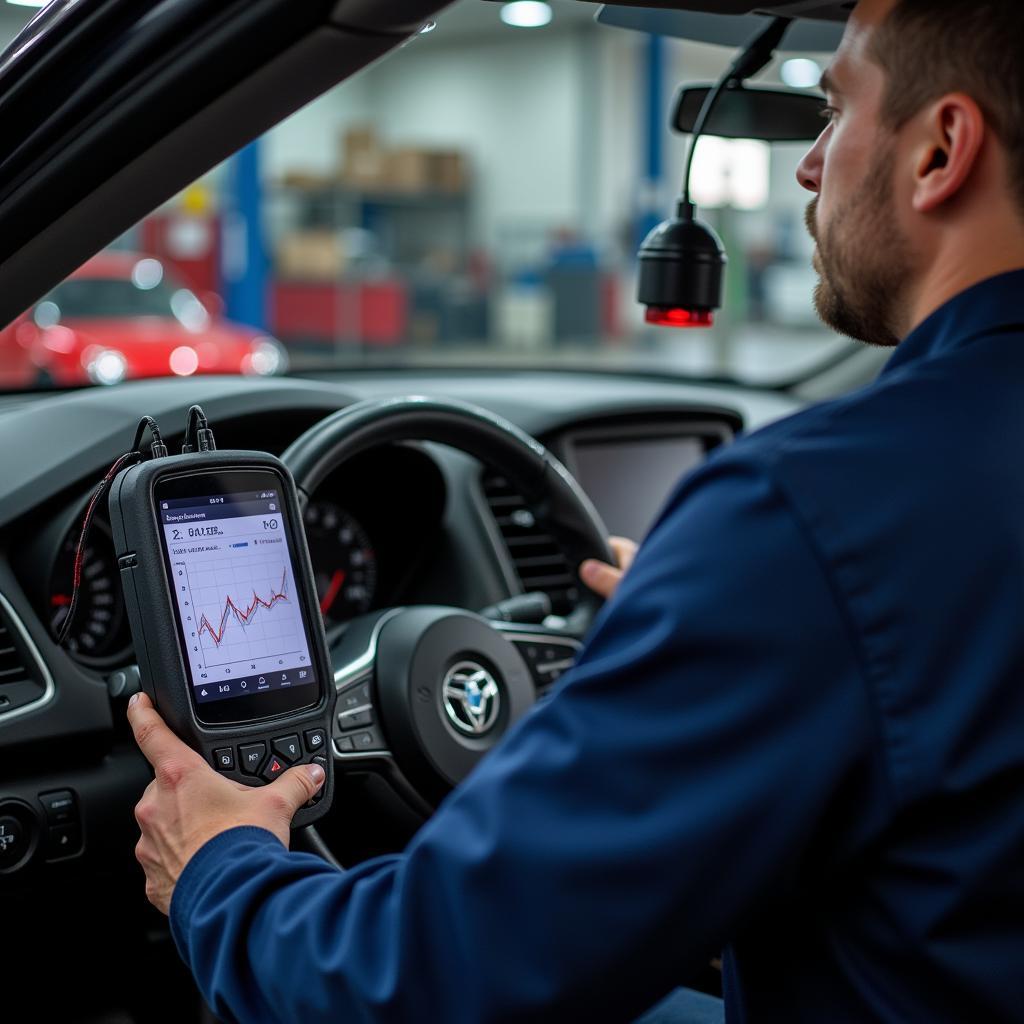Car diagnostic readers, often referred to as OBD2 scanners, have become indispensable tools for both car owners and professional mechanics. These devices unlock a treasure trove of information hidden within your vehicle’s computer system, shedding light on its health, performance, and potential issues. But what exactly do car diagnostic readers tell you, and how can this information be used to your advantage?
Unmasking the Mysteries: What Information Can You Get From a Car Diagnostic Reader?
A car diagnostic reader acts as a direct line of communication between you and your car’s brain – the Engine Control Unit (ECU). By plugging into the OBD2 port, typically located under the dashboard on the driver’s side, these devices can access and translate a wealth of data, including:
- Diagnostic Trouble Codes (DTCs): These alphanumeric codes are the bread and butter of car diagnostics. Each code corresponds to a specific issue detected by the vehicle’s sensors.
- Freeze Frame Data: When a fault occurs, the car’s computer stores a snapshot of critical parameters at that moment, such as engine speed, coolant temperature, and vehicle speed.
- Live Data Stream: Witness your car’s vital signs in real-time. This feature displays live sensor readings, allowing you to monitor parameters like oxygen sensor voltage, fuel pressure, and more.
- Emissions Readiness Status: This crucial information indicates whether your vehicle’s emissions control systems are functioning correctly and ready for an emissions test.
Deciphering the Codes: Understanding and Utilizing Car Diagnostic Reader Information
While accessing the data is the first step, the real power of car diagnostic readers lies in interpreting and utilizing the information effectively.
Identifying Problems: DTCs act as red flags, alerting you to potential issues ranging from minor sensor malfunctions to serious engine problems. However, understanding the code’s meaning is crucial.
Prioritizing Repairs: Not all car problems are created equal. Diagnostic readers help you prioritize repairs based on severity. A flashing check engine light often indicates a serious issue requiring immediate attention.
DIY Diagnostics and Repairs: For the mechanically inclined, car diagnostic readers empower you to diagnose and even fix certain problems yourself.
Saving Money: Early detection through regular diagnostics can prevent small issues from escalating into costly repairs down the line.
 Mechanic Using Professional Car Diagnostic Tool
Mechanic Using Professional Car Diagnostic Tool
Choosing the Right Car Diagnostic Reader: Navigating the Options
The market offers a wide array of car diagnostic readers, catering to different needs and budgets:
- Basic Code Readers: These entry-level devices primarily read and clear basic DTCs.
- Advanced OBD2 Scanners: Offering more features, these scanners provide live data, freeze frame data, and access to manufacturer-specific codes.
- Professional-Grade Scan Tools: Used by mechanics and workshops, these sophisticated tools offer comprehensive diagnostic capabilities, advanced programming functions, and access to all vehicle systems.
“Investing in a reliable car diagnostic reader is akin to equipping yourself with a window into your car’s soul,” says automotive expert John Miller. “It empowers you to understand your vehicle’s language, anticipate potential issues, and make informed decisions regarding its maintenance and repair.”
Beyond Diagnostics: The Evolving Landscape of Car Diagnostic Readers
The world of car diagnostic readers is constantly evolving. With advancements in technology, these devices are becoming increasingly sophisticated, offering features beyond basic diagnostics.
Smartphone Integration: Many modern readers connect to your smartphone via Bluetooth, allowing you to view data, access repair information, and even clear codes from your mobile device.
Predictive Maintenance: Some advanced systems analyze driving habits and sensor data to predict potential issues before they become major problems.
Remote Diagnostics: Imagine receiving a notification on your phone about a potential car issue even before the check engine light illuminates. Remote diagnostics are making this a reality.
Conclusion: Empowering Car Owners Through Information
Car diagnostic readers have transitioned from niche tools to essential equipment for car owners of all levels of expertise. They empower you with the knowledge to understand your vehicle’s health, make informed decisions about repairs, and potentially save money in the long run. By demystifying the complex world of car diagnostics, these devices put you in the driver’s seat when it comes to your vehicle’s well-being.
FAQs:
-
Are car diagnostic readers universal?
Most modern vehicles (1996 onwards) use the standard OBD2 port, making most readers compatible. However, some manufacturer-specific codes may require specialized tools. -
Can I clear my own check engine light with a reader?
Yes, most readers allow you to clear DTCs. However, it’s crucial to address the underlying issue, as simply clearing the code won’t resolve the problem. -
How often should I use my car diagnostic reader?
It’s a good practice to perform a diagnostic scan at least once a month or before long trips to catch potential issues early. -
Can car diagnostic readers drain my car battery?
No, modern readers draw minimal power and won’t drain your battery, even when plugged in for extended periods. -
What should I do if my reader shows a code I don’t understand?
Consult your vehicle’s repair manual, a trusted mechanic, or online resources for code definitions and troubleshooting advice.
Need Assistance? Contact Us!
For any questions or support with car diagnostic tools and techniques, our team of experts is here to help 24/7. Reach out to us via WhatsApp: +1(641)206-8880 or Email: [email protected].

Leave a Reply